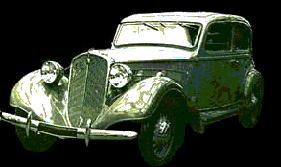Simca "The Story"
On 204 000 vehicles produced in France in 1936. 7 300 approximately were of a new mark which had fit recently in the factories of French cars. It was about Simca. Soci�t� Industrielle of Mecanic and automobileCA rrossery, small company born in Nanterre in the old establishment of the Donnet-Z�del Company which had been dissolved.
The first year of activity represented, with more than 7 000 produced cars, a remarkable result, but it did not certainly make it possible to envisage which powerful development the new arrival was going to know quickly.
In 1938. Simca had already triplet his production, after the war, it was one of the first to be raised of the catastrophe of the conflict. In the Sixties, it had already firmly penetrated the international market and, although being much younger than its competitors, it constituted with Renault. Citroen and Peugeot one of " the four large ones " of the French car industry.
In the Seventies finally, after having entered the American group Chrysler, it was perhaps the French company which felt crisis of the automobile sector.
The craftsman of this success was an Italian. Henri Pigozzi. Come still young to France, it started to recover carcasses of old cars and to dispatch them in Turin for ferrous material r�alimenter the foundries of FIAT. After two years of activity, it had already become general agent of FIAT for the sale of cars on French market. After what in a workshop of Suresnes, it started to assemble FIAT with mechanical parts which either had been imported separately, or built under licence in Paris. From 1928 to 1934, approximately 30 0110 FIAT were assembled and sold by Pigozzi.
A well prepared plan
At the end of 1934, the former scrap merchant, while passing by chance on the road which goes from Paris to Saint-Germain, notices a poster which announced the sale of the old Donnet-Z�del factory.
The situation of French industry in those years was certainly not more flourishing, but Pigozzi acquired of the installations. A little later it founded the Simca company. All this at the price of a very remarkable financial sacrifice, just at a moment to which more stripped of prejudices of the contractors would have acted with a much greater prudence.
The operation of Pigozzi, even if it apparently hazardous and were precipitated, was actually supported by a well prepared plan: it is precisely the difficult situation of the national market which had encouraged it to estimate that by offering carriers of small-engined cars of a popular nature and a moderated price, it would gain a great commercial success.
FIAT produced already the 508 Balilla, which approached the ideal whose Pigozzi promised success, but especially it had in project a small car, the 500 Topolino, with the characteristics even more economic and utility. The activity of the establishment of Nanterre began in 1935 and, for a short period, it was limited to the assembly of the FIAT Balilla, sold under mark FIAT France. It was acted in fact of the same activity that the Franco-Italian industrialist exerted since years in the small workshop of Suresnes. The principal objective in sight of which had been made up the Simca company on the other hand was achieved the following year (1936): in April, the first Simca-cFiat came out, faithful counterpart of the 500 Topolino.
With the difference of what had occurred for Balilla and models FIAT precedents, new the Simca-cFiat, marked figure 5, was built completely in France, although being based on the projects FIAT of which Pigozzi and its technicians were useful themselves according to the agreements occurred with the factory of Turin.
Briefly let us indicate the design features of this first Simca: engine with before with four cylinders on line of 569 Cm3, distribution with side valves, power of 13 CH, speed of 85 km/h. The price of 9 900 francs was definitely competitive. The success of this small car in France could have been much larger if trade-union agitations of the time on several occasions had not blocked its production. Pigozzi however succeeds in making face with the critical situation which had been created inside the company and, in 1937, it was able to present a new model, always carried out on the basis of project FIAT and more precisely on those of the 508 C/1100.
The mark of this car was not any more Simca-Fiat, but simply Simca. Like the preceding model (Simca-Cinq), this one also had a numerical denomination: Simca-Huit. The engine was 4-cylinders in line of 1 098 Cm3 (32 CH, 110 km/h). The production of Simca-Cinq reached its maximum point in 1938 with 14194 specimens, while the model Eight arrived to its node after the war.









